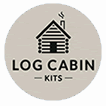Log Cabin DIY Installation
Call Now 01342 477774
A Brief Guide for DIYers
Key Points for a successful Build
Our garden buildings have been designed for a competent DIY enthusiast to construct with no previous experience. Basic hand tool ability is all that is required to achieve a successful build.
Our own installers have gathered years of experience in building this style of building. Below is a list of key points that if followed, will help avoid common pitfalls
- It is important to check off each component against the list found within the installation guide supplied with the cabin. If, in the very rare occasion an item is missing, it is best to discover this before the build has started in case replacements are not immediately available.
- Distribute the components around the site so that they are near to hand in their final resting place. This makes for a more efficient build.
- Although the logs are machined perfectly true at manufacture, timber being a natural resource will in some cases twist as the moisture content changes. If you are faced with a twisted log, don't panic ! Try to use these in the wall no higher than log number 8. This ensures there is sufficient weight above it to hold in place. In extreme cases use the supplied screws to help. See Note 1
- As you build the walls, check to make sure the wall is building vertically with the use of a plumb line or spirit level. Also check for squareness. Measure the distance diagonally across the cabin from corner to corner, these should be equal. If you find the cabin out of square, use a sledge hammer or similar to nudge the offending side into position until the diagonals are equal.
- Fixing the roof. Start at the front by placing a tongue and groove roof board level with the front edge of the roof joist. It is good practice to temporarily attach a long board onto the centre roof joist that determines the position of each roof board central to the joist. Once you have completed one side, remove the temporary board and work your way down the second side.
- Before attaching any of the fascia or roof trims it is good practice to pre-treat with your preferred product. This ensures all surfaces have been treated prior to fitting where access can lead to some parts being left exposed.
- Doors and windows can all be fitted after the main shell has been build.
- In order to have the doors and windows sitting central to the opening, you may need to position some small packers under each frame. This ensures the framing boards are provided with sufficient width to cover the gaps. These gaps are there for a purpose - don't panic ! As the moisture content in the wall changes, so will the wall dimensions. The gap allows the wall to move independently of the door or window.
Note 1. - Although in most cases the manufacturers are now supplying long screws to fix the wall boards to each other, in our opinion, best practice is not to use them unless there is no other way of using a warped or twisted board. Wood is a natural material and its moisture content and shape will change through the seasons. If the wall boards are screwed in place, this prevents them from finding their natural home - in the worst case could prevent logs sitting flush in the grooves and opening up a small gap.
Finally, if you come across an issue that you cannot understand or work around, call the office or mobile. we will be pleased to assist
